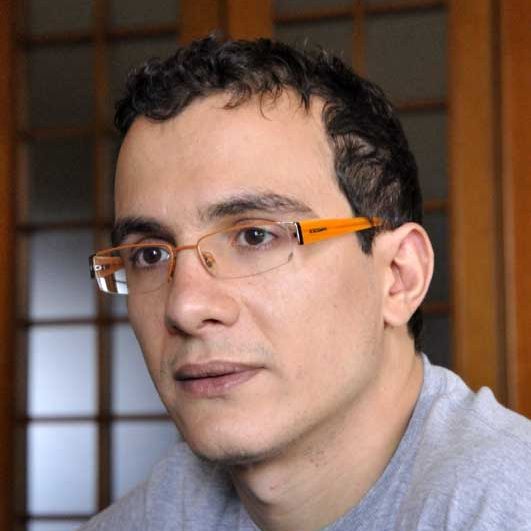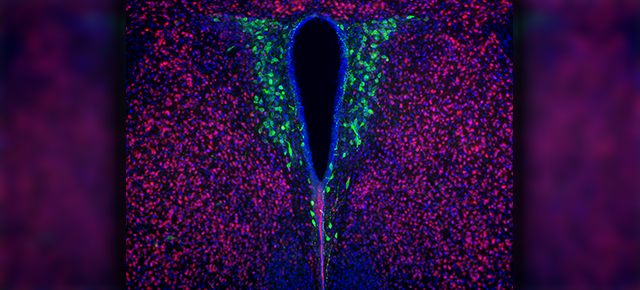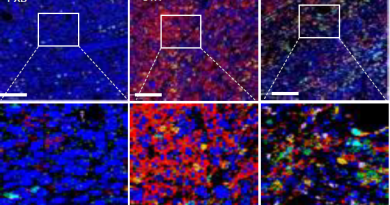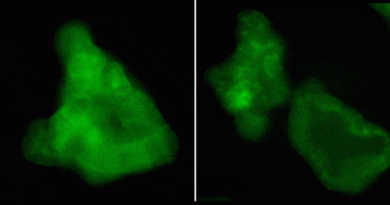Many paths to degeneration for neurons
By Ruth SoRelle, M.P.H.
Adult neurons are touchy. Too much protein can throw them off course, resulting in neurodegeneration.

After showing how mutant ATAXIN1 (the protein associated with the neurodegenerative disorder spinocerebellar ataxia 1) cannot fold and be discarded properly, resulting in malfunctioning neurons, Dr. Huda Zoghbi, professor of molecular and human genetics at Baylor College of Medicine and director of the Jan and Dan Duncan Neurological Research Institute at Texas Children’s Hospital and Baylor and her colleagues have found an RNA-binding protein called PUMILIO1 that regulates ATAXIN1 levels. Loss of PUMILIO1 activity – as when it is knocked out or lost –increases the amount of normal ATAXIN1 in the cell and, in studies of mice, causes neurodegeneration that mimics that of spinocerebellar ataxia 1.
Symptoms
People and animals that have this disorder first lose balance and then slowly begin to lose the ability to swallow and, in people, speak. Sooner or later, spasticity and paralysis result and eventually the patient dies. However, the disorder spinocerebellar ataxia 1 is fairly rare, occurring in approximately 1 to 2 in 100,000 people. It is inherited dominantly when the faulty protein is mutated. Each child of a person with the disorder has a one in two chance of inheriting the faulty gene and inheriting the disease.
Now, in a report that appears in the journal Cell, Zoghbi and Dr. Vincenzo A. Gennarino (postdoctoral fellow in Zoghbi’s laboratory and the Neurological Research Institute), and their colleagues demonstrate that an RNA-binding protein called PUMILIO1 also regulates levels of the ATAXIN1 protein. When a mouse lacks one copy of the PUMILIO1 gene, the amount of ATAXIN1 increases, starting early in development. The mouse that loses the copy or copies of PUMILIO1 develops symptoms reminiscent of spinocerebellar ataxia 1, loss of motor coordination and degeneration of Purkinje neurons in the cerebellum. Eliminating the copy of the PUMILIO1 gene in mice that already lack a copy of ATAXIN1 reduces the abnormal symptoms and rescues the animals from the disease.
Precise levels

The researchers postulate that it is essential to maintain precise levels of both proteins – PUMILIO1 AND ATAXIN1. If that balance is lost, the animals develop symptoms of the neurodegenerative disease. Mutations that decrease PUMILIO1 levels by 50 percent or increase ATAXIN1 levels by 30-50 percent at an early stage in development can cause early onset degeneration of the cerebellum..
“This finding is important. There may be patients who lack a functional copy of PUMILIO1 through a copy number variation or a mutation that inactivates it. Such patients are at risk of early onset neurodegeneration. Patients who have a duplication of ATAXIN1 (an extra copy) are at risk for childhood ataxia,” said Zoghbi, who is also a professor of pediatrics, neuroscience, and neurology and a Howard Hughes Medical Institute investigator.
“If we could find a treatment that reduces ATAXIN1 early on, it would be helpful in the long term,” she said. “It gives hope in this disease.”
Just right amount
The findings with PUMILIO1 demonstrate that neurons require just the right amount of the important protein – not too much and not too little.
“It shows that cells in the brain are not tolerant of too much of a normal protein,” she said. “If we can come back and slightly decrease those proteins early in life before the system falters, we may have an effect.”
“For the late onset spinocerebellar ataxia 1, if we could come up with a strategy to find molecules to decrease the mutant ATAXIN1 – no more than 10 to 20 percent – we might be able to relieve the disease.”
“This could be important in the study of other neurodegenerative diseases. We don’t know what proteins are involved and what happens in diseases such as Parkinson’s, Alzheimer, amyotrophic lateral sclerosis and similar disorders,” said Gennarino. “For these and other neurodegenerative conditions that do not fit Mendelian categories, it may prove most fruitful to find factors that elevate the levels of the key disease-driving proteins.”
Others who took part in this work include Ravi K. Singh, Joshua J. White, Antonia De Maio, Kihoon Han, Ji-Yoen Kim, Paymaan Jafar-Nejad, Alberto di Ronza, Hyojin Kang, Layal S. Sayegh, Thomas A. Cooper and Roy V. Sillitoe of Baylor and Harry T. Orr of the Institute for Translational Neuroscience, University of Minnesota at Minneapolis.
Funding for this program came from the National Institute of Neurological Disorders and Stroke (Grant NS27600 to H.Y.Z.) and the RNA In Situ Hybridization, Confocal and Mouse Behavioral Cores at the BCM Intellectual and Developmental Disabilities Research Center (IDDRC; Grant National Institutes of Health/National Institute of Child Health and Human Development Grant HD024064) and (Grant 1R01NS089664-01 to R.V.S.) as well as the Howard Hughes Medical Institute.




When your neurodegeneration research reach the stage 3, where you need testing with active patients, I would like to volunteer for that. On December 2014, I was diagnosed as having early stage of Parkinson’s disease by Dr. Blumb. I will be very happy to be your tester.